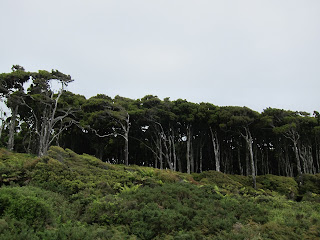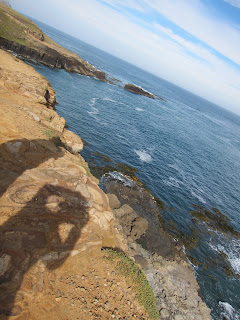Mountains are great. After a while of wow-ing at mountain after mountain, though, one starts wanting something a bit more relaxed...
...like some cows by the sea:
...or some weird round rocks on a beach:
So this post will be about scenes of animals and ocean-related scenes. We'll start with the native wildlife.
Glowworms in the forest
Our first night, we walked out into the forest (on a fairly) well-marked path to see glowworms. They looked like this:
If that's not impressive, turn off all the lights and then imagine you're in a strange forest in the mountains.
The glowworms' spot wasn't especially interesting in the daylight - just some bushes. If we'd been glowworms, we would have lived in a spot like this (which we walked by a few days later):
Birds
Unfortunately, we didn't see any kiwi birds... though they're apparently pretty reclusive. Nor, more surprisingly, did we see any kea - a mountain parrot that is not remotely reclusive.
But we did see this:
It's not a duck - the beak was too pointy.
We also saw this gull (who clearly has a taste for lighting) eating a crab:
The real excitement, though, was penguin-spotting. This is a yellow-eyed penguin we saw on the south coast:
The landscape here is significant - we'll talk about that later.
Seals and sea lions
The only native mammals in New Zealand are sea-related: either sea-ls, or sea-lions.
In Milford sound, we got to see seals hanging out on a rock:
Very cute.
Sea lions are less cute. We saw some in a couple spots, though there were signs warning one not to get too close - the recommended minimum distance was 10 meters.
Here's what we think are a parent and child:
The vast majority of animals we saw, though, were non-native. Normally, they wouldn't be photo-worthy, but with the right setting...
Non-human European mammal invaders: Sheep, cows, and hedgehogs
We learned that sheep farming is declining in NZ, due to less demand for wool. Many farmers are switching to cows.
But we didn't have any shortage of sheep. We even got to have the road blocked by them:
Most of the sheep we saw weren't on the move, though. They seemed to just be posing.
There were sheep of the mist:
Sheep of the lighthouse (that little thing in the middle):
And sheep of the mountains:
Cows were most places sheep were - we didn't see any obvious pattern about who went where. These cows are across the road from some rock art that we'll return to in a later post:
The biggest surprise was a hedgehog:
The internet tells us that they were introduced in the late 1800's to control garden pests. That plan, as usual, didn't work, and now they're wiping out lots of native species. But they're still awfully cute...
We'll finish with some sea-related landscapes.
Pancake rocks
On our second day, we took a detour north to see the 'pancake rocks' - so-called because (with some creative imagining), they look like stacks of pancakes.
Funky. This was where we saw the brown bird that wasn't a duck.
Trees by the sea
By the pancake rocks (and along most of the west coast) were these Nikau Palm trees. They seemed very self confident, like a new toothbrush:
These were wind-swept trees a bit to the south:
Scenes from the Catlins
The Catlins area covers most of the southern coast. It doesn't get as much attention as the western coast, since it's less mountain-y. But we loved it. It felt a bit like the end of the earth - it was the furthest south either of us had ever been:
Below, in fact, is the southernmost point in New Zealand. You can see that our shadows made it a bit further south than we did (the cliffs were crumbly):
Here is a petrified forest in the sea - you can still see the shapes of logs. This was where the above penguin made his/her appearance. Good taste:
One of the our favorite spots was a set of sea caves that can only be visited for about 4 hours during low tide. We were lucky enough to get the timing right. Here's a view looking out:
A view looking in:
And the view of Colin walking casually by:
The most dramatic spot, though, was called 'Nugget Point.' The point was at the end of a steep ridge, with mist racing up the side:
This is the view from the end - those rocks vanishing into the mists are the 'nuggets':
To round out this post - a classic sunset shot. We were lucky enough to catch this sunset - just the right mix of seamist and late light:
Next post: human civilisation....




























No comments:
Post a Comment